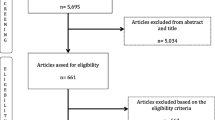Abstract
Background
Robot-assisted surgery using the da Vinci Surgical System provides three-dimensional images. However, no research has yet been done on the relationship between the system’s operation and spatial cognitive ability. This study focuses on the operator’s spatial cognitive ability which can impact acquisition of the skills required to operate the da Vinci Surgical System.
Methods
The participants of the study were 20 volunteers who were students at Hiroshima University (9 men and 11 women, average age 21.1 ± 1.6 years). Depending on the mental rotation test’s score the participants were divided into two groups, one with High group (n = 10), and the other with Low group (n = 10). Both groups were tested using Hiroshima University endoscopic surgical assessment device (HUESAD) and the da Vinci Surgical System simulator dV-Trainer.
Results
HUESAD; No significant difference was noted between the two groups in terms of smoothness (p = 0.3867). In terms of accuracy and spatial cognitive ability, the High group scored significantly lower values than the Low group. dV-Trainer; In terms of overall Score, no significant difference was seen between the two groups (pick and place: p = 0.1639; peg board: p = 0.1883; thread the rings: p = 0.8928; suture sponge: p = 0.3238).
Conclusions
This study indicates that differences in spatial cognitive ability have no impact at the initial stages to operate the da Vinci Surgical System. Despite this, it should be repeated that the da Vinci Surgical System is not something that facilitates simple surgery that can be implemented by anyone.





Similar content being viewed by others
References
Memon S, Heriot AG, Murphy DG, Bressel M, Lynch AC (2012) Robotic versus laparoscopic proctectomy for rectal cancer: a meta-analysis. Ann Surg Oncol 19:2095–2101
Yang Y, Wang F, Zhang P, Shi C, Zou Y, Qin H, Ma Y (2012) Robot-assisted versus conventional laparoscopic surgery for colorectal disease, focusing on rectal cancer: a meta-analysis. Ann Surg Oncol 19:3727–3736
Hagen ME, Wagner OJ, Inan I, Morel P (2009) Impact of IQ, computer-gaming skills, general dexterity, and laparoscopic experience on performance with the da Vinci surgical system. Int J Med Robot 5:327–331
Mucksavage P, Kerbl DC, Lee JY (2011) The da Vinci® Surgical System overcomes innate hand dominance. J Endourol 25:1385–1388
Kolozsvari NO, Andalib A, Kaneva P, Cao J, Vassiliou MC, Fried GM, Feldman LS (2011) Sex is not everything: the role of gender in early performance of a fundamental laparoscopic skills. Surg Endosc 25:1037–1042
Suleman R, Yang T, Paige J, Chauvin S, Alleyn J, Brewer M, Johnson SI, Hoxsey RJ (2010) Hand-eye dominance and depth perception effects in performance on a basic laparoscopic skills set. JSLS 14:35–40
Adams BJ, Margaron F, Kaplan BJ (2012) Comparing video games and laparoscopic simulators in the development of laparoscopic skills in surgical residents. J Surg Educ 69:714–717
Jungmann F, Gockel I, Hecht H, Kuhr K, Räsänen J, Sihvo E, Lang H (2011) Impact of perceptual ability and mental imagery training on simulated laparoscopic knot-tying in surgical novices using a Nissen fundoplication model. Scand J Surg 100:78–85
Shepard RN, Metzler J (1971) Mental Rotation of Three-Dimensional Objects. Science 171:701–703
Egi H, Okajima M, Yoshimitsu M, Ikeda S, Miyata Y, Masugami H, Kawahara T, Kurita Y, Kaneko M, Asahara T (2008) Objective assessment of endoscopic surgical skills by analyzing direction-dependent dexterity using the Hiroshima University endoscopic surgical assessment device (HUESAD). Surg Today 38:705–710
Egi H, Tokunaga M, Hattori M, Ohdan H (2012) Evaluating the correlation between the HUESAD and OSATS score: concurrent validity study. Minim Invasive Ther Allied Technol 22:144–149
Martin JA, Regehr G, Reznick R, Macrae H, Murnahan J, Hutchison C, Brown M (1997) Objective structured assessment of technical skill (OSATS) for surgical residents. Br J Surg 84:273–278
Egi H, Okajima M, Kawahara T, Yoshimitsu M, Sumitani D, Tokunaga M, Takeda H, Itamoto T, Ohdan H (2010) Scientific assessment of endoscopic surgical skills. Minim Invasive Ther Allied Technol 19:30–34
Tokunaga M, Egi H, Hattori M, Yoshimitsu, Sumitani D, Kawahara T, Okajima M, Ohdan H (2012) Approaching time is important for assessment of endoscopic surgical skills. Minim Invasive Ther Allied Technol 21:142–149
Hung AJ, Zehnder P, Patil MB, Cai J, Ng CK, Aron M, Gill IS, Desai MM (2011) Face, content and construct validity of a novel robotic surgery Simulator. J Urol 186:1019–1024
Perrenot C, Perez M, Tran N, Tran N, Jehl JP, Felblinger J, Bresler L, Hubert J (2012) The virtual reality simulator dV-Trainer is a valid assessment tool for robotic surgical skills. Surg Endosc 26:2587–2593
Lee JY, Mucksavage P, Kerbl DC, Huynh VB, Etafy M, McDougall EM (2012) Validation study of a virtual reality robotic simulator—role as an assessment tool? J Urol 187:998–1002
Egi H, Hattori M, Tokunaga M, Suzuki T, Kawaguchi K, Sawada H, Ohdan H (2013) Face, content and concurrent validity of the mimic dV-Trainer for robot assisted endoscopic surgery:a prospective study. European Surgical Resarc 50:292–300
Blavier A, Gaudissart Q, Cadière GB, Nyssen AS (2006) Impact of 2D and 3D vision on performance of novice subjects using da vinci robotic system. Acta Chir Belg 106:662–664
Disclosures
Drs. Hiroyuki Egi, Minoru Hattori, Takahisa Suzuki, Hiroyuki Sawada and Hideki Ohdan have no competing interests or financial ties to disclose.
Author information
Authors and Affiliations
Corresponding author
Rights and permissions
About this article
Cite this article
Egi, H., Hattori, M., Suzuki, T. et al. The significance of spatial cognitive ability in robot-assisted surgery. Surg Endosc 29, 1130–1136 (2015). https://doi.org/10.1007/s00464-014-3773-6
Received:
Accepted:
Published:
Issue Date:
DOI: https://doi.org/10.1007/s00464-014-3773-6




